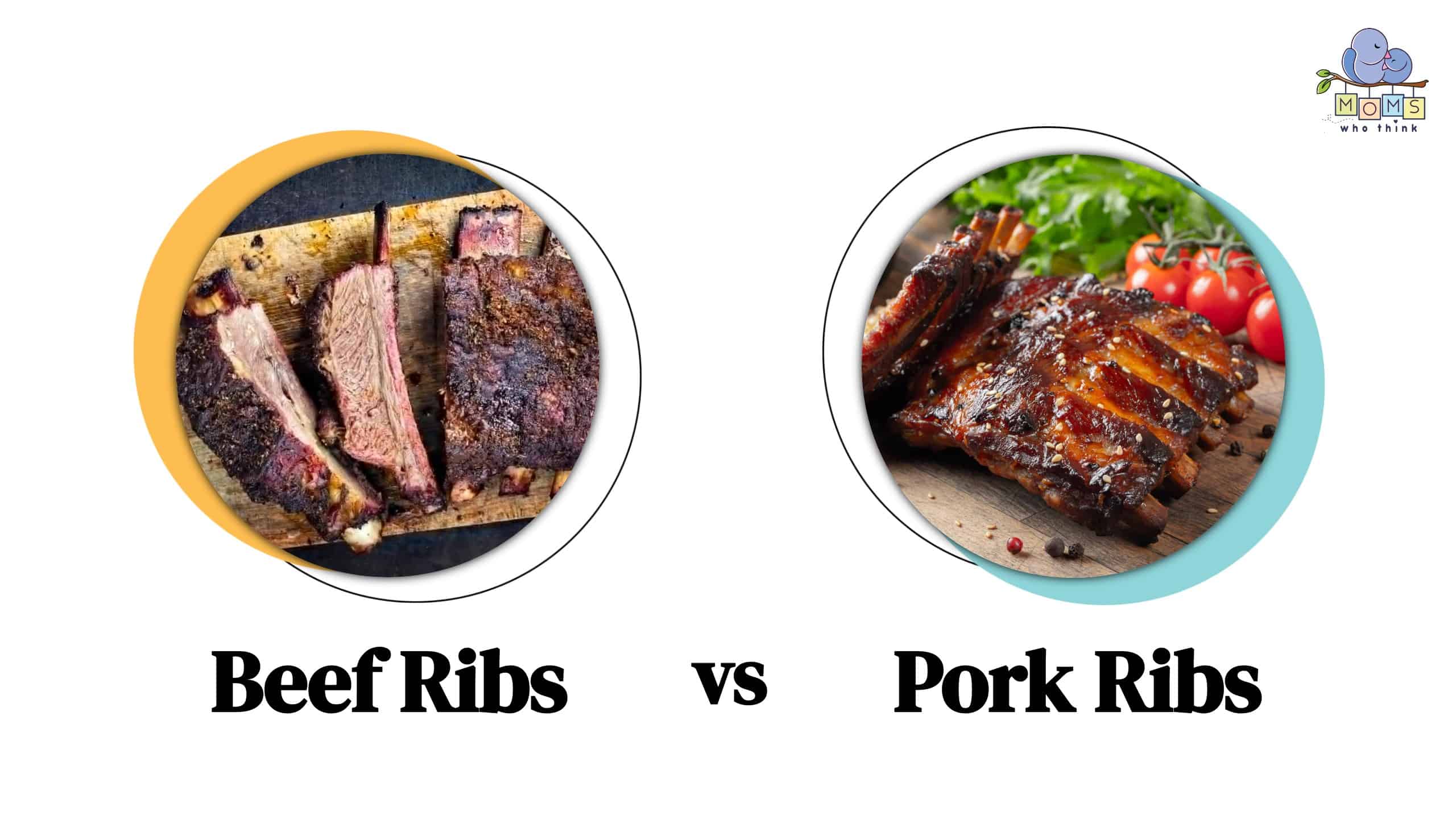Pork has the highest consumption of meat worldwide. Beef follows close behind. Both of these animals provide plenty of cuts of tasty meat that offer numerous benefits. So, it's no wonder we would find a way to use every bit of each animal. This includes the ribs! Even though they sound similar, the difference between pork and beef ribs is plenty.
In a nutshell, the main difference is where each rib comes from. Pork rib comes from a pig, and beef rib from a cow.
More differences include the flavor and the fat content. Let's take a look below at the fundamental differences.
- The must-have convenient reference guide for every home cook!
- Includes more than 8,000 substitutions for ingredients, cookware, and techniques.
- Save time and money on by avoiding trips to grab that "missing" ingredient you don't really need.
Beef Ribs vs. Pork Ribs: What are the Differences?
Beef and pork ribs, while coming from the same place, have some basic differences.
The very first difference is the animal they are from. This is the most obvious answer. However, let's dig a bit deeper. The size of the ribs will also range.
Beef ribs are larger in size. But, of course, this makes sense, considering the fact that one animal is relatively more prominent in size than the other!
Another difference is the fat content of each. Beef ribs contain more fat, possibly due to the large nature of the animal. The ribs also contain more marbling than pork ribs.
Texture and Taste
Another one of the differences between the two is the flavor. Pork ribs have a sweet undertone. The taste is milder than beef ribs. Think more of a pork chop and the flavor it has. This is very similar to pork ribs. The flavor is porky, mild, and a bit sweet.
On the other hand, beef ribs are typically stronger and bolder in flavor than pork ribs. In addition, they have a robust meaty taste. The meat is also very tender because of the significant fat content and marbling throughout.
Both pork ribs and beef ribs take well to marinades and seasoning. Barbequing ribs is a favorite pastime for many people! The rubs and marinades for either one of these ribs will vary slightly. Pork ribs usually use marinades and seasoning with a sweeter and milder sauce or rub. Contrarily, beef ribs take to a stronger, hearty marinade that may pack a bit of a punch.
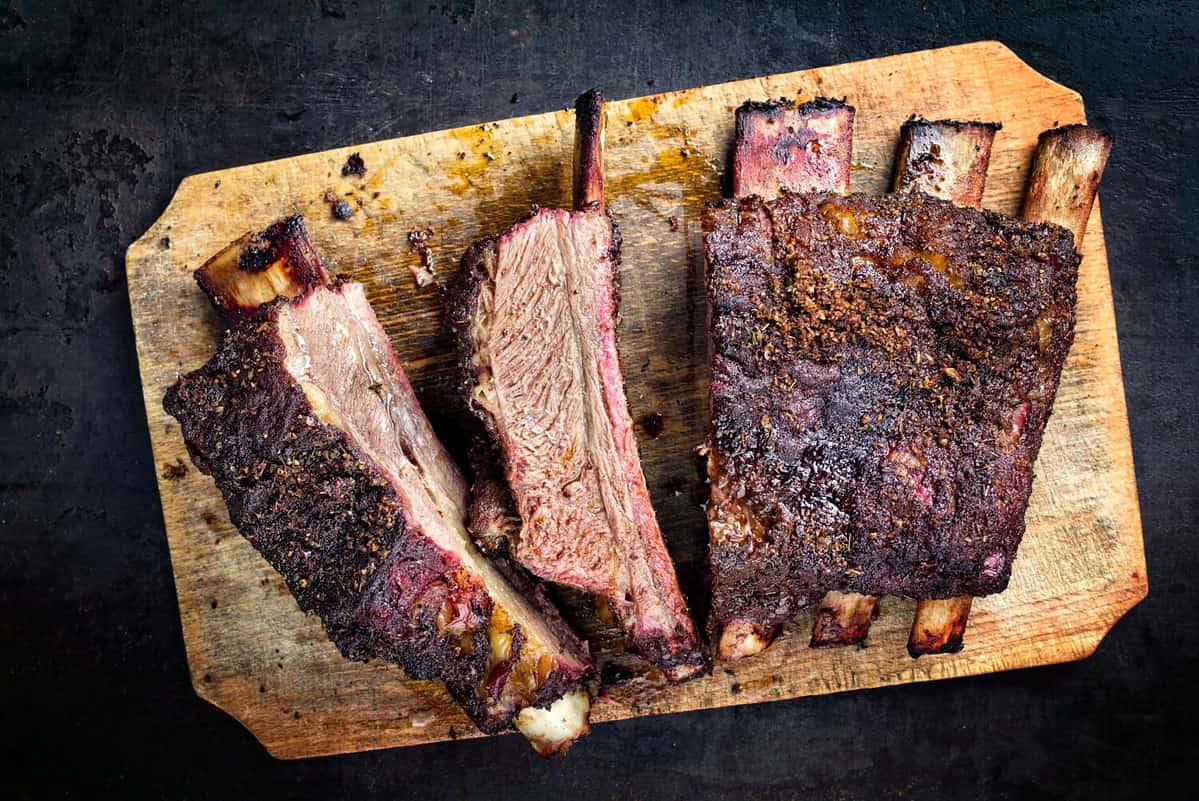
Beef ribs are strong and intense in flavor and take well to many robust marinades and seasonings.
©hlphoto/Shutterstock.com
Preparation Methods
The preparation methods of both beef and pork ribs range. Fortunately, there are many different ways to cook ribs. However, some easy ways exist to make tender and flavorful pork and beef ribs; thankfully, the methods are interchangeable!
Other than grilling and smoking, ribs also cook great in the oven. One simple way to do this is to place the ribs on a baking sheet, season them, and place them in a 350-degree oven for 20 minutes. The meat will start to brown.
At this point, take them out, marinate them with your chosen sauce, and place them back in the oven, flipping halfway, about ten minutes in. After twenty minutes, take them back out, add more sauce and tent aluminum foil over the top of the ribs, and do not let them touch the top! Next, turn the oven to 250 degrees Fahrenheit and place the ribs back in for two hours. Check frequently to be sure the sauce doesn't burn.
This is a simple yet delicious way to prepare your favorite ribs right in your own kitchen!
Beef Ribs vs. Pork Ribs Nutritional Value
When it comes to nutritional value, beef ribs, and pork ribs do not vary significantly. They both are higher in calories, with beef ribs containing 230 calories in three ounces and pork ribs containing 250 calories. They are also higher in cholesterol, coming out at 70mg and 75 mg. However, they both contain loads of protein, zinc, vitamin B12, and iron! The chart below provides a great snapshot of the comparison between the two.
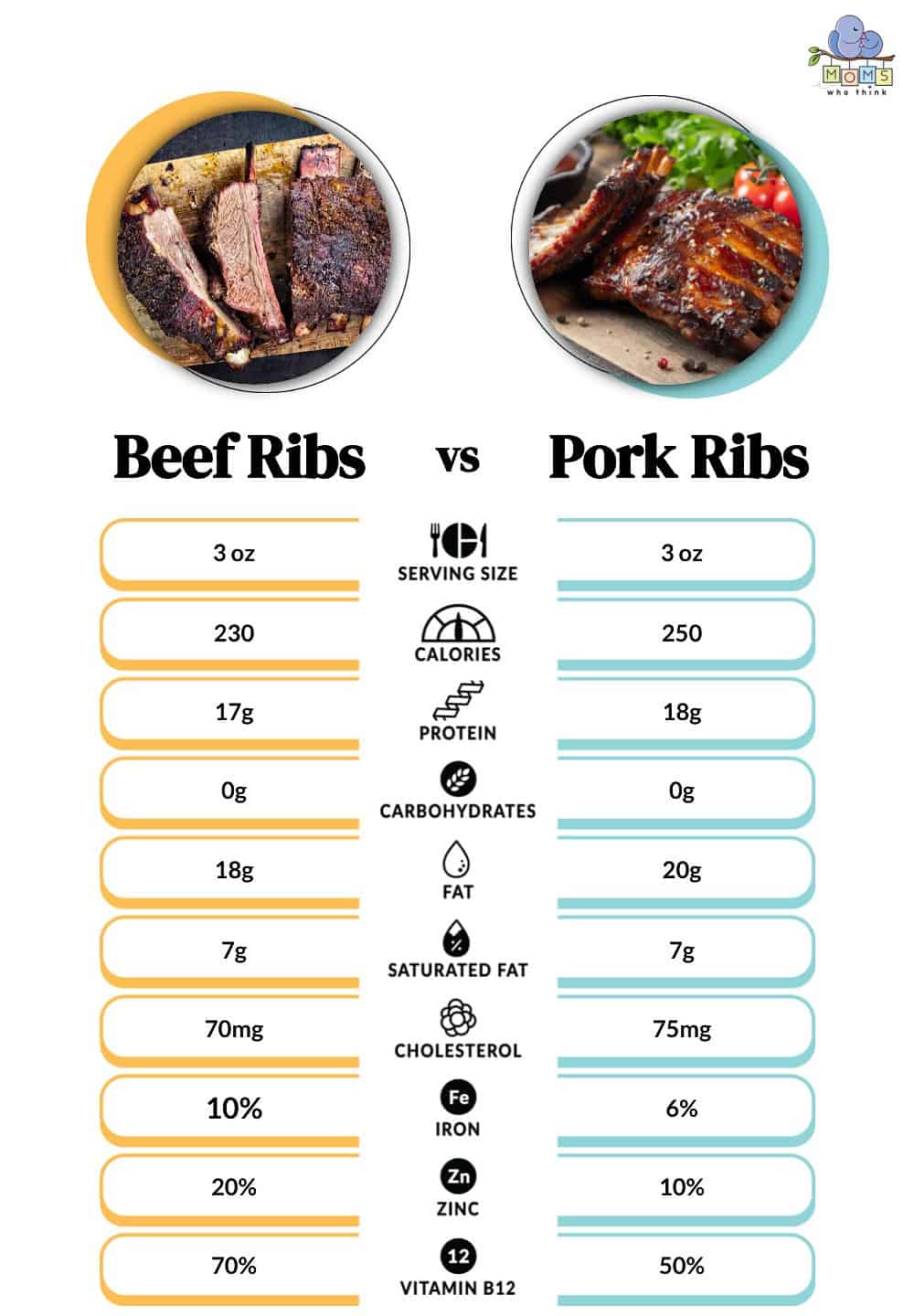
©
What Are Beef Ribs?
When someone is referring to a beef rib, they will be talking about one of three types. Either, chuck short ribs plate short ribs, or back ribs. These three types are a variation of the 13 ribs on the beef's side.
Plate short ribs tend to be large, have plenty of meat on them, and the meat is very tender. Many people enjoy barbequing this type of rib. One of the reasons the meat is so tender is because of the connective tissue in this area of the cow. There is also a lot of fat! The fat and connective tissue will melt while cooking, creating decadent and melt-in-your-mouth meat.
Back ribs are located on the breast and go up the spine. They do not have as much meat as a short plate rib, but they are still delicious in their own right!
Chuck's short ribs count from the first rib to the fifth rib. They are the cheapest at the grocery store and have meat at the bone's end. The rib bones themselves are not as large as the plate short rib.
What Are Pork Ribs?
Pork ribs are the ribs that come from a pig. The rib is cut and sold with the meat still attached, typically in one large piece. Pork ribs are similar to beef ribs, but they differ in taste.
Pork ribs have a sweet undertone, much like the rest of the meat from pork. Yet, they are also very versatile, meaning they take well to any seasoning or marinade you pair them with.
Like beef ribs, there are a few cuts of pork ribs. First, there are the back ribs. They are on the back of the pig and carry plenty of meat and fat.
Spare ribs are the lower section of the ribs. These are located in the belly of the pig. They have more fat than back ribs because of this. However, they are not quite as tender as the back ribs.
St. Louis ribs refer to the spare ribs cut from the breastbone. Attached to it are the rib tips that are usually sold separately.
Country-style ribs are from the shoulder of the pig. So, even though it touts the name ribs, it isn't even a rib!
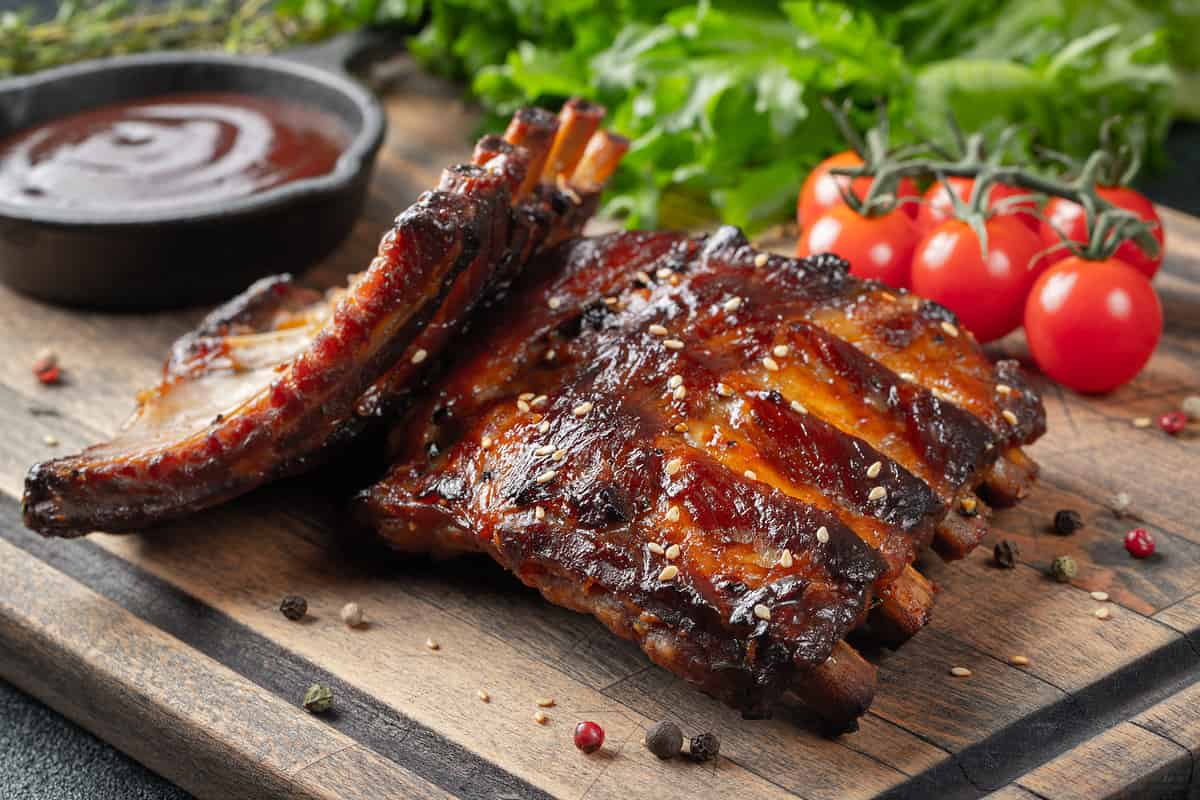
Pork ribs are delicious and mild in flavor. They can be cooked in a similar way to beef ribs.
©vasiliybudarin/Shutterstock.com
Can You Substitute Beef Ribs for Pork Ribs?
It can be possible if you are in a scrap or want to switch one out for the other! However, in doing so, there are a few key factors that you will need to remember.
The first thing to remember is that beef ribs taste stronger and bolder, while pork ribs are lighter in taste. If you substitute pork ribs with beef ribs, prepare for the beefy, robust, and strong taste.
Another thing to remember is to adjust your cook times. For instance, beef ribs are larger and usually take longer to cook.
What it all boils down to, however, is your personal preference. With this in mind, you can absolutely substitute one for the other!
- The must-have convenient reference guide for every home cook!
- Includes more than 8,000 substitutions for ingredients, cookware, and techniques.
- Save time and money on by avoiding trips to grab that "missing" ingredient you don't really need.
One Last Note
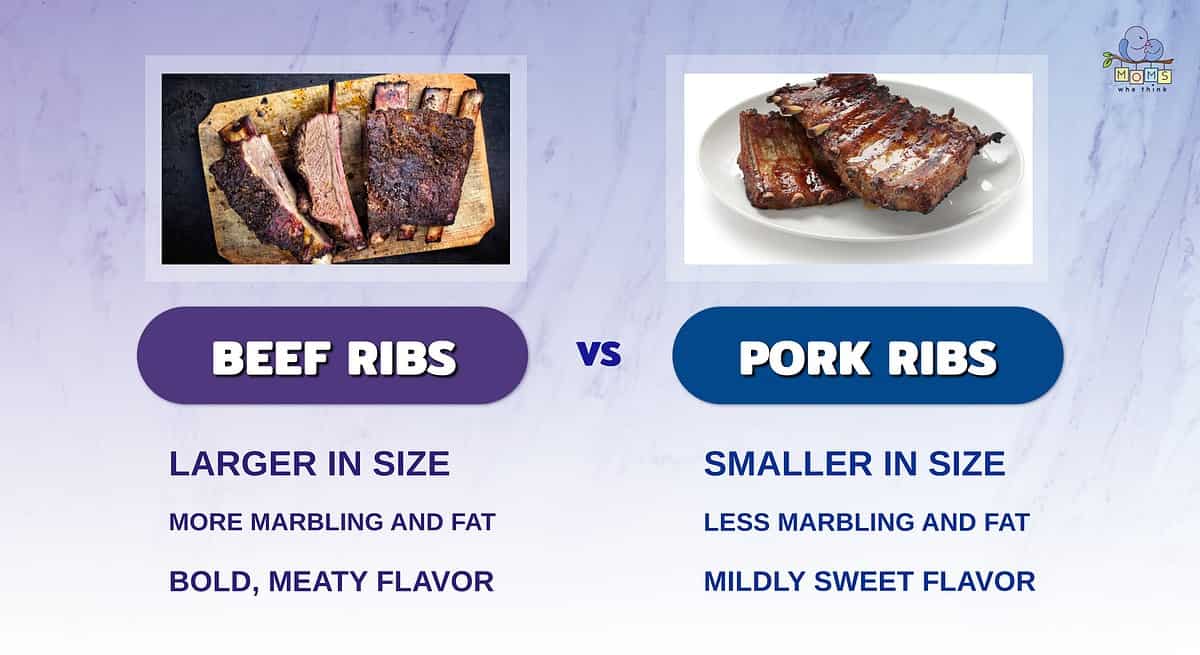
- Beef ribs are larger in size, which makes sense considering cows are much larger than pigs.
- Pork ribs have less marbling, which in turn means they have less fat. This makes them a good pick for those on a diet.
- Beef ribs have a bold, meaty flavor, while pork ribs have a mildly sweet flavor comparable to pork chops.
Regarding beef ribs and pork ribs, both are delicious, meaty, and packed with flavor. It is all about your own preference if you are trying to figure out which one to use for your next dinner party. Both beef and pork ribs take well to grilling, smoking, or even in the oven.
They also are great when you marinate them in a flavorful sauce or rub them with various spices. Pork ribs happen to be milder in flavor and smaller in size. However, don't discount them! They are still just as delicious as beef ribs.
Beef ribs contain more meat and have a more intense flavor. Whether you eat beef or pork ribs, they are both delicious and, remember, quite messy!
Check out this fantastic Kansas City Pork Ribs recipe:
Print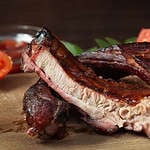
Kansas City Pork Ribs
Ingredients
3 slabs pork back ribs
1/2 cup sugar
1/4 cup paprika
3 Tablespoons seasoned salt
2 Tablespoons chili powder
2 Tablespoons ground black pepper
1 Tablespoon celery salt
1 Tablespoon onion powder
1 Tablespoon garlic powder
2 teaspoons ground sage
1 teaspoon dry mustard
1 cup any type barbecue sauce
1/2 cup honey
Instructions
In pint-jar with tight-fitting lid, combine sugar, paprika, seasoned salt, chili powder, black pepper, celery salt, onion powder, garlic powder, ground sage and dry mustard.
Place lid on jar and shake jar to combine thoroughly. Set spice rub aside. Makes about 1 1/2 cups.
In small saucepan over low heat, stir together barbecue sauce and honey. Heat through, stirring occasionally, about 5 minutes. Set barbecue glaze aside, keep warm or at room temperature before using. (If storing for more than 2 hours, cover and refrigerate. Reheat gently before using).
Pat ribs dry with paper towels and season generously with spice rub, using about 4-6 Tablespoons for each slab of ribs.
Grill over indirect heat in a covered grill or smoker for 1 1/2 to 2 hours. Turn ribs once during cooking, about halfway through.
Ribs are done when the meat is very tender; they will pull apart fairly easily. About 20 minutes before ribs are done, baste heavily with barbecue glaze.
Comparison Posts
- Pork vs. Beef: The Difference Between Two Of The Most Popular Meats
- Beef vs Steak: What's the Difference Between the Two
- Boston Butt vs. Pork Shoulder: Texture, Taste, And Nutrient Differences Between The Two
- Pork Belly vs. Bacon: One Location, Two Very Different Types Of Meat
- Chicken Thighs vs Drumsticks: Similarities and Differences Of The Two
